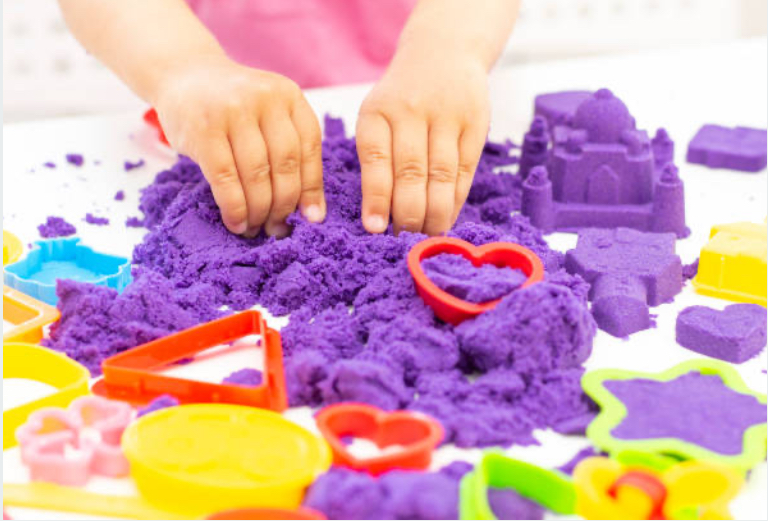Ever watched a child completely mesmerized by something, their hands exploring, their imagination soaring? If you’re looking for an activity that delivers exactly that – a captivating, calming, and endlessly creative experience – then it’s time to introduce your little one (or even yourself!) to the wonderful world of sensory sand, often known by its popular brand name, kinetic sand.
It’s more than just sand; it’s a sensory powerhouse!
Our Sensory Sand Top Picks
1. Sensory Play Kit and Sand Art
We appreciate this amazing sensory play kit for its wide array of accessories and vibrant hues, while the built-in lid makes tidying up a breeze.
2. SlimySand Scented Sand
SlimySand scented sensory sand with its berry scent and it’s fun moldable texture it’s the perfect sensory gift for tactile, visual, and olfactory sensory seekers.
3.Cake & Ice Cream Sensory Sand Kit
We love this kit for its vibrant colors and its cute ice cream and cake themed accessories. It’s a great imagination play kit. Also comes with bin and lid.
What Exactly Is This “Magic” Sand, and How Does It Work?
Imagine sand that sticks to itself, yet feels dry. Sand that you can mold, squish, slice, and crumble, but never leaves a sticky residue. That’s sensory sand!
At its core, sensory sand is a blend of ultra-fine sand (usually about 98%) and a special polymer, often a form of silicone (like polydimethylsiloxane). This polymer is the secret ingredient that gives it its unique, “kinetic” properties.
Here’s the science-ish bit: The polymer coats each grain of sand, creating a kind of “glue” that allows the sand particles to cling to each other without feeling wet or sticky. When you press it, the polymer allows the sand to hold its shape. When you gently let it go, it flows and separates almost like a slow-motion liquid, creating those mesmerizing, satisfying trickles. It’s truly a marvel of modern play materials!
The Sensory Superpowers: Benefits of Playing with Sensory Sand
Sensory play is vital for development, and sensory sand ticks so many boxes. Here’s why it’s a fantastic addition to any play routine:
- Tactile Exploration & Desensitization: The unique texture – soft, pliable, yet firm when pressed – provides rich tactile input. For children who are sensitive to textures, this can be a gentle way to explore and become more comfortable with different sensations. For those who seek sensory input, its malleable nature is incredibly satisfying.
- Fine Motor Skills Development:Pinching, rolling, squeezing, cutting, and shaping the sand are all excellent exercises for strengthening the small muscles in the hands and fingers, crucial for tasks like writing, zipping, and buttoning.
- Calming & Regulating: The repetitive motions of squishing, molding, and watching the sand flow can be incredibly calming and meditative. It’s a wonderful tool for self-regulation, helping children (and adults!) de-stress, focus, and wind down.
- Creativity & Imagination:Sensory sand is the ultimate open-ended toy. There are no rules, no right or wrong way to play. This encourages imaginative scenarios, storytelling, and free expression.
- Cognitive Development: Children explore concepts like cause and effect, weight, volume, and transformation as they manipulate the sand. They might plan out structures, problem-solve how to make a certain shape, or learn about different tools.
- Hand-Eye Coordination:Activities like scooping, pouring, and precise cutting with tools all require and improve hand-eye coordination.
- Language & Communication: As children play, they often narrate their actions, describe textures, and engage in imaginative dialogue, building their vocabulary and communication skills.
Ways to Unleash the Fun with Sensory Sand
The beauty of sensory sand is its versatility. You don’t need fancy equipment, but a few simple additions can spark endless adventures:
- Simply Hands: The most basic and often most satisfying way to play is just with hands. Squish it, flatten it, pull it apart, watch it flow.
- Cookie Cutters & Molds: Classic playdough tools work perfectly! Create animals, stars, hearts, or letters.
- Rollers & Cutters: Use a small rolling pin to flatten it out, then plastic knives or pizza cutters to slice it.
- Scoops & Spoons: Practice scooping and pouring into small cups or bowls.
- Small Toys: Integrate mini construction vehicles, farm animals, or action figures for themed play. Build roads, pastures, or alien landscapes.
- Baking Station: Pretend to bake cakes, cookies, or pies. Decorate with beads, small pebbles, or even real sprinkles (if you’re brave!).
- Construction Site: Use toy trucks and diggers to create hills, valleys, and construction zones.
- Hidden Treasures: Bury small toys or gems for a “treasure hunt” activity.
Caring for Your Sensory Sand & Cleanup Tips
One of the great joys of sensory sand is how easy it is to manage:
- Storage: Always store your sensory sand in an airtight container to prevent it from drying out or absorbing too much moisture from the air.
- Keep it Dry: Water and humidity are its enemies! Avoid getting it wet, as this can change its texture and make it sticky.
- Play on a Tray: For easier cleanup, contain the mess by playing on a large tray, a plastic placemat, or even inside a plastic bin.
- Cleanup: The best way to clean up stray pieces? Use a larger chunk of sensory sand to “pick up” the smaller bits – they’ll stick right to it! A hand-held vacuum also works wonders.
Beyond the Sand: Similar Sensory Experiences
If sensory sand hits the mark, you might also enjoy exploring these other sensory play materials:
- Playdough/Clay: A classic for a reason, offering tactile input and endless molding possibilities.
- Slime: Offers a very different, often gooey and stretchy, tactile experience.
- Water Beads: Small, squishy, gel-like beads that are incredibly satisfying to touch and scoop. (Supervise closely, as they are a choking hazard for young children).
- Oobleck (Cornstarch & Water): A non-Newtonian fluid that acts as both a solid and a liquid, providing a fascinating scientific and sensory exploration.
- Sensory Bins (Rice, Beans, Pasta): Fill a bin with dry rice, beans, pasta, or even pompoms and add scoops, cups, and small toys for a different kind of tactile play.
Sensory sand offers a truly unique and enriching play experience that engages multiple senses and fosters development in countless ways. So, go ahead, get your hands in that magical sand, and prepare to be amazed by the simple joys of sensory exploration!
What are your favorite ways to play with sensory sand? Share your ideas in the comments below!


